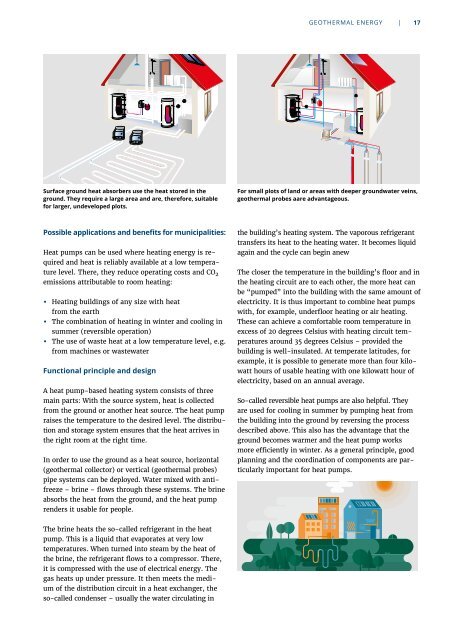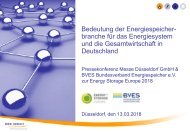Renewable Energy – Solutions for application in the communal energy infrastructure
This brochure contains a selection of successful renewable energy solutions suitable for a range of applications for local and national municipalities and economies. The main energy end-use sectors and the current state of the energy transition are briefly explained to provide readers with an understanding of the transformation of the greater energy system. The renewable energy technology options are explained, including their relevance and applications for municipalities. Finally, a selection of exemplary projects that have been successfully implemented in Europe, the Russian Federation and Central Asia, are included to demonstrate real applications and use-cases for renewable solutions. Renewable energies are cheap, clean and versatile.
This brochure contains a selection of successful renewable energy solutions suitable for a range of applications for local and national municipalities and economies. The main energy end-use sectors and the current state of the energy transition are briefly explained to provide readers with an understanding of the transformation of the greater energy system. The renewable energy technology options are explained, including their relevance and applications for municipalities. Finally, a selection of exemplary projects that have been successfully implemented in Europe, the Russian Federation and Central Asia, are included to demonstrate real applications and use-cases for renewable solutions. Renewable energies are cheap, clean and versatile.
You also want an ePaper? Increase the reach of your titles
YUMPU automatically turns print PDFs into web optimized ePapers that Google loves.
GEOTHERMAL ENERGY |<br />
17<br />
Surface ground heat absorbers use <strong>the</strong> heat stored <strong>in</strong> <strong>the</strong><br />
ground. They require a large area and are, <strong>the</strong>re<strong>for</strong>e, suitable<br />
<strong>for</strong> larger, undeveloped plots.<br />
For small plots of land or areas with deeper groundwater ve<strong>in</strong>s,<br />
geo<strong>the</strong>rmal probes aare advantageous.<br />
Possible <strong>application</strong>s and benefits <strong>for</strong> municipalities:<br />
Heat pumps can be used where heat<strong>in</strong>g <strong>energy</strong> is required<br />
and heat is reliably available at a low temperature<br />
level. There, <strong>the</strong>y reduce operat<strong>in</strong>g costs and CO 2<br />
emissions attributable to room heat<strong>in</strong>g:<br />
• Heat<strong>in</strong>g build<strong>in</strong>gs of any size with heat<br />
from <strong>the</strong> earth<br />
• The comb<strong>in</strong>ation of heat<strong>in</strong>g <strong>in</strong> w<strong>in</strong>ter and cool<strong>in</strong>g <strong>in</strong><br />
summer (reversible operation)<br />
• The use of waste heat at a low temperature level, e.g.<br />
from mach<strong>in</strong>es or wastewater<br />
Functional pr<strong>in</strong>ciple and design<br />
A heat pump-based heat<strong>in</strong>g system consists of three<br />
ma<strong>in</strong> parts: With <strong>the</strong> source system, heat is collected<br />
from <strong>the</strong> ground or ano<strong>the</strong>r heat source. The heat pump<br />
raises <strong>the</strong> temperature to <strong>the</strong> desired level. The distribution<br />
and storage system ensures that <strong>the</strong> heat arrives <strong>in</strong><br />
<strong>the</strong> right room at <strong>the</strong> right time.<br />
In order to use <strong>the</strong> ground as a heat source, horizontal<br />
(geo<strong>the</strong>rmal collector) or vertical (geo<strong>the</strong>rmal probes)<br />
pipe systems can be deployed. Water mixed with antifreeze<br />
<strong>–</strong> br<strong>in</strong>e <strong>–</strong> flows through <strong>the</strong>se systems. The br<strong>in</strong>e<br />
absorbs <strong>the</strong> heat from <strong>the</strong> ground, and <strong>the</strong> heat pump<br />
renders it usable <strong>for</strong> people.<br />
<strong>the</strong> build<strong>in</strong>g’s heat<strong>in</strong>g system. The vaporous refrigerant<br />
transfers its heat to <strong>the</strong> heat<strong>in</strong>g water. It becomes liquid<br />
aga<strong>in</strong> and <strong>the</strong> cycle can beg<strong>in</strong> anew<br />
The closer <strong>the</strong> temperature <strong>in</strong> <strong>the</strong> build<strong>in</strong>g’s floor and <strong>in</strong><br />
<strong>the</strong> heat<strong>in</strong>g circuit are to each o<strong>the</strong>r, <strong>the</strong> more heat can<br />
be “pumped” <strong>in</strong>to <strong>the</strong> build<strong>in</strong>g with <strong>the</strong> same amount of<br />
electricity. It is thus important to comb<strong>in</strong>e heat pumps<br />
with, <strong>for</strong> example, underfloor heat<strong>in</strong>g or air heat<strong>in</strong>g.<br />
These can achieve a com<strong>for</strong>table room temperature <strong>in</strong><br />
excess of 20 degrees Celsius with heat<strong>in</strong>g circuit temperatures<br />
around 35 degrees Celsius <strong>–</strong> provided <strong>the</strong><br />
build<strong>in</strong>g is well-<strong>in</strong>sulated. At temperate latitudes, <strong>for</strong><br />
example, it is possible to generate more than four kilowatt<br />
hours of usable heat<strong>in</strong>g with one kilowatt hour of<br />
electricity, based on an annual average.<br />
So-called reversible heat pumps are also helpful. They<br />
are used <strong>for</strong> cool<strong>in</strong>g <strong>in</strong> summer by pump<strong>in</strong>g heat from<br />
<strong>the</strong> build<strong>in</strong>g <strong>in</strong>to <strong>the</strong> ground by revers<strong>in</strong>g <strong>the</strong> process<br />
described above. This also has <strong>the</strong> advantage that <strong>the</strong><br />
ground becomes warmer and <strong>the</strong> heat pump works<br />
more efficiently <strong>in</strong> w<strong>in</strong>ter. As a general pr<strong>in</strong>ciple, good<br />
plann<strong>in</strong>g and <strong>the</strong> coord<strong>in</strong>ation of components are particularly<br />
important <strong>for</strong> heat pumps.<br />
The br<strong>in</strong>e heats <strong>the</strong> so-called refrigerant <strong>in</strong> <strong>the</strong> heat<br />
pump. This is a liquid that evaporates at very low<br />
temperatures. When turned <strong>in</strong>to steam by <strong>the</strong> heat of<br />
<strong>the</strong> br<strong>in</strong>e, <strong>the</strong> refrigerant flows to a compressor. There,<br />
it is compressed with <strong>the</strong> use of electrical <strong>energy</strong>. The<br />
gas heats up under pressure. It <strong>the</strong>n meets <strong>the</strong> medium<br />
of <strong>the</strong> distribution circuit <strong>in</strong> a heat exchanger, <strong>the</strong><br />
so-called condenser <strong>–</strong> usually <strong>the</strong> water circulat<strong>in</strong>g <strong>in</strong>








